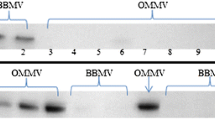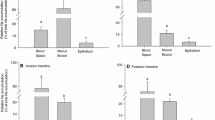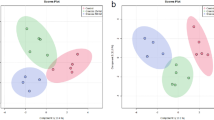Abstract
Cephaloridine, which accumulates in the renal proximal tubule, is a model compound used for studying the toxicity of antibiotics towards this nephron segment. Several studies have demonstrated that cephaloridine alters renal intermediary and energy metabolism, but the mechanism by which this compound interferes with renal metabolic pathways remains incompletely understood. In an attempt to improve our knowledge in this field, we have studied the influence of cephaloridine on the synthesis of glutamine, which represents a key metabolic process involving several important enzymatic steps in the rabbit kidney. For this, suspensions of rabbit renal proximal tubules were incubated for 90 and 180 min in the presence of 5 mM alanine, an important glutamine precursor, both in the absence and the presence of 10 mM cephaloridine. Glutamate accumulation and glutamine synthesis were found to be inhibited by cephaloridine after 90 and 180 min of incubation, and cephaloridine accumulation in the renal proximal cells occurred in a time-dependent manner. The renal proximal tubule activities of alanine aminotransferase and glutamate dehydrogenase, which initiates alanine removal and releases the ammonia needed for glutamine synthesis, respectively, were inhibited to a significant degree and in a concentration-dependent manner by cephaloridine concentrations in the range found to accumulate in the renal proximal cells. Citrate synthase and glutamine synthetase activities were also inhibited by cephaloridine, but to a much lesser extent. The above enzymatic activities were not found to be inhibited when they were measured after successive dilutions of renal proximal tubules incubated for 180 min in the presence of 5 mM alanine and 10 mM cephaloridine. When microdissected segments (S1–S3) of rabbit renal proximal tubules were incubated for 180 min with 5 mM alanine with and without 5 and 10 mM cephaloridine, glutamate accumulation and glutamine synthesis were also inhibited in the three renal proximal segments studied; the latter cephaloridine-induced inhibitions observed were concentration-dependent except for glutamine in the S3 segment. These results are consistent with the view that cephaloridine accumulates and is toxic along the entire rabbit renal proximal tubule. They also demonstrate that cephaloridine interferes in a concentration-dependent and reversible manner mainly with alanine aminotransferase and glutamate dehydrogenase, which are therefore newly-identified targets of the toxic effects of cephaloridine in the rabbit renal proximal tubule.





Similar content being viewed by others
References
Anthony ML, Gartland KP, Beddell CR, Lindon JC, Nicholson JK (1992) Cephaloridine-induced nephrotoxicity in the Fischer 344 rat: proton NMR spectroscopic studies of urine and plasma in relation to conventional clinical chemical and histopathological assessments of nephronal damage. Arch Toxicol 66:525–537
Child KJ, Dodds MG (1966) Mechanism of urinary excretion of cephaloridine and its effects on renal function in animals. Br J Pharmacol 26:108–119
Conjard A, Dugelay S, Chauvin MF, Durozard D, Baverel G, Martin G (2002) The anaplerotic substrate alanine stimulates acetate incorporation into glutamate and glutamine in rabbit kidney tubules A 13C NMR study. J Biol Chem 277:29444–29454
Dugelay S, Chauvin MF, Megnin-Chanet F, Martin G, Lareal MC, Lhoste, JM, Baverel G (1999) Acetate stimulates flux through the tricarboxylic acid cycle in rabbit renal proximal tubules synthesizing glutamine from alanine: a 13C NMR study. Biochem J 342:555–566
Ferrier B, Conjard A, Martin M, Baverel G (1999) Glutamine synthesis is heterogeneous and differentially regulated along the rabbit renal proximal tubule. Biochem J 337:543–550
Goldstein RS, Pasino DH, Hewitt WR, Hook JB (1986) Biochemical mechanisms of cephaloridine nephrotoxicity: time- and concentration-dependence of peroxidative injury. Toxicol Appl Pharmacol 83:261–270
Goldstein RS, Contardi L, Pasino DA, Hook JB (1987) Mechanisms mediating cephaloridine inhibition of renal gluconeogenesis. Toxicol Appl Pharmacol 87:297–305
Goldstein RS, Smith PF, Tarloff JB, Contardi L, Rush GF, Hook JB (1988) Biochemical mechanisms of cephaloridine nephrotoxicity. Life Sci 42:1809–1816
Hörder M, Rej R (1983) Alanine aminotransferase (glutamate pyruvate transaminase). In: Bergmeyer HU (ed) Methods of enzymatic analysis, vol 3. Academic, New York, pp 444–450
Imbert M, Chabardès D, Montégut M, Clique M, Morel F (1975) Adenyl cyclase activity along the rabbit nephron as measured in single isolated segments. Pflügers Arch 354:213–228
Inui KI, Masuda S, Saito H (2000) Cellular and molecular aspects of drug transport in the kidney. Kidney Int 58:944–958
Kaissling B, Kriz W (1979) Structural analysis of the rabbit kidney. In: Brodal A, Hild W, Van Limborgh J, Ortmann R, Schiebler TH, Töndery G, Wolff E (eds) Advances in anatomy, embryology and cell biology, vol 56. Springer-Verlag, Berlin Heidelberg New York, pp 108
Kiyomiya KY, Matsushita N, Matsuo S, Kurebe M (2000) Cephaloridine-induced inhibition of cytochrome c oxidase activity in the mitochondria of cultured renal epithelial cells (LLC-PK1) as a possible mechanism of its nephrotoxicity. Toxicol Appl Pharmacol 167:151–156
Kuo CH, Maita K, Sleight SD, Hook JB (1983) Lipid peroxidation : A possible mechanism of cephaloridine-induced nephrotoxicity. Toxicol Appl Pharmacol 67:78–88
Lash LH, Tokarz JJ, Woods EB (1994) Renal cell type specificity of cephalosporin-induced cytotoxicity in suspensions of isolated proximal tubular and distal tubular cells. Toxicology 94:97–118
McKinney TD (1982) Heterogeneity of organic base secretion by proximal tubules. Am J Physiol 243:F404–F407
Passonneau JV, Lowry OH (1993) Enzymatic analysis: a practical guide. Humana, Totowa, NJ
Prusiner S, Milner L (1970) A rapid radioactive assay for glutamine synthetase, glutaminase, asparagine synthetase, and asparaginase. Anal Biochem 37:429–438
Rush GF, Ponsler GD (1991) Cephaloridine-induced biochemical changes and cytotoxicity in suspensions of rabbit isolated proximal tubules. Toxicol Appl Pharmacol 109:314–326
Rush GF, Heim RA, Ponsler GD, Engelhardt J (1992) Cephaloridine-induced renal pathological and biochemical changes in female rabbits and isolated proximal tubules in suspension. Toxicol Pathol 20:155–168
Schmidt E, Schmidt FW (1983) Glutamate dehydrogenase. In: Bergmeyer HU (ed) Methods of enzymatic analysis, vol 3. Academic, New York, pp 216–227
Signs SA, File TM, Tan JS (1984) High pressure liquid chromatography method for analysis of cephalosporins. Antimicrob Agents Chemother 26:652–655
Silverblatt F, Turck M, Bulger R (1970) Nephrotoxicity due to cephaloridine: a light-microscopic and electron-microscopic study in rabbits. J Infect Dis 122:33–44
Stitt M (1983) Citrate synthase (condensing enzyme). In: Bergmeyer HU (ed) Methods of enzymatic analysis, vol 3. Academic, New York, pp 353–358
Takeda M, Tojo A, Sekine T, Hosoyamada M, Kanai Y, Endou H (1999) Role of organic anion transporter 1 (OAT1) in cephaloridine (CER)-induced nephrotoxicity. Kidney Int 56:2128–2136
Tune BM (1975) Relationship between the transport and toxicity of cephalosporins in the kidney. J Infect Dis 132:189–194
Tune BM, Fernholt M (1973) Relationship between cephaloridine and P-aminohippurate transport in the kidney. Am J Physiol 225:114–1117
Tune BM, Fravert D (1980) Cephalosporin nephrotoxicity: transport, cytotoxicity and mitochondrial toxicity of cephaloglycin. J Pharmacol Exp Ther 215:186–190
Tune BM, Hsu CY (1990) The renal mitochondrial toxicity of cephalosporins: specificity of the effect on anionic substrate uptake. J Pharmacol Exp Ther 252:65–69
Tune BM, Hsu CY (1995) Effects of nephrotoxic β-lactam antibiotics on the mitochondrial metabolism of monocarboxylic substrates. J Pharmacol Exp Ther 274:194–199
Tune BM, Fernholt M, Schwartz A (1974) Mechanism of cephaloridine transport in the kidney. J Pharmacol Exp Ther 191:311–317
Tune BM, Wu KY, Fravert D, Holtzman D (1979) Effect of cephaloridine on respiration by renal cortical mitochondria. J Pharmacol Exp Ther 210:98–100
Tune BM, Sibley RK, Hsu CY (1988) The mitochondrial respiratory toxicity of cephalosporine antibiotics: an inhibitory effect on substrate uptake. J Pharmacol Exp Ther 245:1054–1059
Tune, BM, Fravert D, Hsu CY (1989) Oxidative and mitochondrial toxic effects of cephalosporin antibiotics in the kidney. A comparative study of cephaloridine and cephaloglycin. Biochem Pharmacol 38:795–802
Vandewalle A, Wirthensohn G, Heidrich HG, Guder WG (1981) Distribution of hexokinase and phosphoenolpyruvate carboxykinase along the rabbit nephron. Am J Physiol 240:F492–F500
Wold JS (1981) Cephalosporin nephrotoxicity. In: Hook JB (ed) Toxicology of the kidney. Raven, New York, pp 251–266
Wold JS, Turnipseed SA (1977) Determination of cephaloridine in serum and tissue by high performance liquid chromatography. J Chromatogr 136:170–173
Wold JS, Turnipseed SA, Miller BL (1979) The effect of renal cation transport inhibition on cephaloridine nephrotoxicity. Toxicol Appl Pharmacol 47:115–122
Acknowledgements
We thank Claire Morel for her assistance in the preparation of this manuscript. Assaad Eid was supported by a fellowship from the CNRSL (Lebanon). Experiments were performed in accordance with current French laws.
Author information
Authors and Affiliations
Corresponding author
Rights and permissions
About this article
Cite this article
Guitton, J., Conjard, A., Eid, A. et al. Identification of novel targets of cephaloridine in rabbit renal proximal tubules synthesizing glutamine from alanine. Arch Toxicol 79, 587–594 (2005). https://doi.org/10.1007/s00204-005-0673-5
Received:
Accepted:
Published:
Issue Date:
DOI: https://doi.org/10.1007/s00204-005-0673-5




